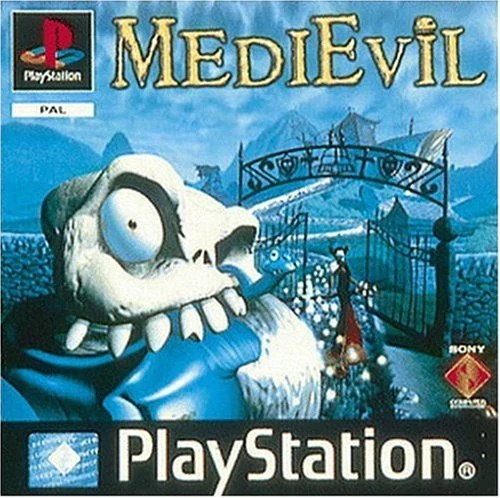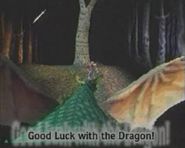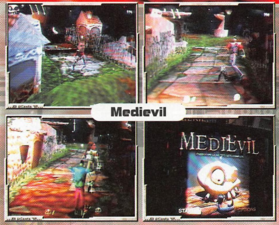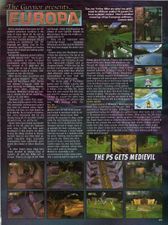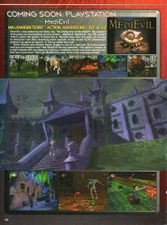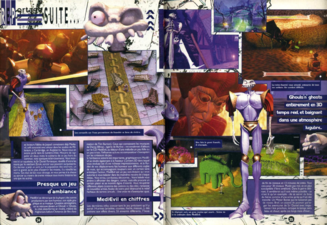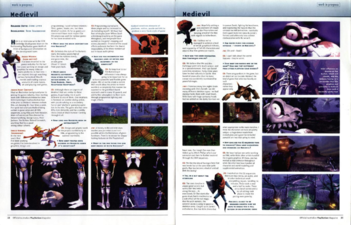MediEvil (partially found original arcade version of PlayStation action-adventure game; 1997-1998): Difference between revisions
No edit summary |
mNo edit summary |
||
| Line 17: | Line 17: | ||
* '''Health Pick-up''' - Instead of an energy vial, there were two energy bones (green bone for health refill, and blue bone for extending the health bar). | * '''Health Pick-up''' - Instead of an energy vial, there were two energy bones (green bone for health refill, and blue bone for extending the health bar). | ||
* '''Scoring''' - Players can earn score points instead of souls, as the chalice was not implemented at that time. Points can be earned by not only killing enemies but also collecting money bags. | * '''Scoring''' - Players can earn score points instead of souls, as the chalice was not implemented at that time. Points can be earned by not only killing enemies but also collecting money bags. | ||
* '''Stamina''' - The stamina meter was a mechanic that was seen in the game's E3 1997 footage. It represents as a bar in between two icons of Dan's skull: the left icon shows Dan grinning and the right shows Dan frowning. When Dan starts running, the stamina will display at the bottom center of the screen, slowly draining. If the stamina runs out, it will automatically force Dan to stop running, before re-filling back up. The stamina was featured in few prototypes but seems to be broken. In the late-1997/early-1998 trailer, the stamina was not there, suggesting that the mechanic was likely scrapped. | * '''Stamina''' - The stamina meter was a mechanic that was seen in the game's E3 1997 footage. It represents as a bar in between two icons of Dan's skull: the left icon shows Dan grinning and the right shows Dan frowning. When Dan starts running, the stamina will display at the bottom center of the screen, slowly draining. If the stamina runs out, it will automatically force Dan to stop running, before re-filling back up. The stamina was featured in few prototypes but seems to be broken. In the late-1997/early-1998 trailer, the stamina was not there, suggesting that the mechanic was likely scrapped. | ||
* '''Chests''' - Chests were originally purple and textured with a question mark. They seal not only the small sword, throwing daggers, club, or any shields but also other weapons and sometimes potions. | * '''Chests''' - Chests were originally purple and textured with a question mark. They seal not only the small sword, throwing daggers, club, or any shields but also other weapons and sometimes potions. | ||
* '''Enemies''' - | * '''Enemies''' - The enemies can spawn and respawn frequently. Sometimes they can drop pick-ups upon death. | ||
* '''Weapons''' - Instead of unlocking weapons from the Hall of Heroes (which was not planned before), weapons were found in chests but there is no inventory to switch weapons. Range weapons have unlimited use. | * '''Bosses''' - The bosses' health bar is originally red instead of yellow, and a lack of visible health points. On top of that, the Guardians of the Graveyard are the only bosses not to appear in the arcade version, due to the "Return to the Graveyard" level remain unplanned. Instead, a hulking, headless blue humanoid boss was originally planned to appear in the cut "Circle of Shadows" level. | ||
* '''Weapons''' - A total number of 14 weapons was planned, but other weapons like the hammer and arm are not included, with the trident originally included but was left cut in the game's final version. Instead of unlocking weapons from the Hall of Heroes (which was not planned before), weapons were found in chests but there is no inventory to switch weapons. Range weapons have unlimited use. | |||
* '''Gargoyles''' - The Information Gargoyles were formerly called "Help Gargoyles" and meant to appear in a bigger number as the player's recurring guide before they were replaced by books in the final version. They can be seen in the prototype's preview screenshots from ''PlayStation Zone Demo Volume 1''. Regardless of the game's direction change, the gargoyles as books were still used for a couple of 1998 prototypes until in later versions. | * '''Gargoyles''' - The Information Gargoyles were formerly called "Help Gargoyles" and meant to appear in a bigger number as the player's recurring guide before they were replaced by books in the final version. They can be seen in the prototype's preview screenshots from ''PlayStation Zone Demo Volume 1''. Regardless of the game's direction change, the gargoyles as books were still used for a couple of 1998 prototypes until in later versions. | ||
| Line 65: | Line 66: | ||
The only footage that has been seen from the cut dragon level exist in the form of a few snippets which can be found in an old ''MediEvil'' pre-release trailer, as well as in a short making-of documentary (both included on various PlayStation 1 demo discs, and both of which have since been uploaded to YouTube). In addition, there exists an FMV (that, at first glance, seems to have been intended to take place before the "Inside the Asylum" level) that was cut from the final game, however, this FMV can still be seen by using an FMV viewer within ''MediEvil'', unlockable via cheat code. Interestingly, clips from this FMV can too be seen in the pre-release trailer. | The only footage that has been seen from the cut dragon level exist in the form of a few snippets which can be found in an old ''MediEvil'' pre-release trailer, as well as in a short making-of documentary (both included on various PlayStation 1 demo discs, and both of which have since been uploaded to YouTube). In addition, there exists an FMV (that, at first glance, seems to have been intended to take place before the "Inside the Asylum" level) that was cut from the final game, however, this FMV can still be seen by using an FMV viewer within ''MediEvil'', unlockable via cheat code. Interestingly, clips from this FMV can too be seen in the pre-release trailer. | ||
Found deep | Found deep within the Rolling Demo's files, there were unused texture assets for the dragon level as well as the Jabberwocky itself. A nearly-finished map layout for the level can also be accessed in the September 1997 prototype, but due to its unfinished state, the Jabberwocky cannot spawn. | ||
=== Morten Levels === | === Morten Levels === | ||
| Line 86: | Line 87: | ||
The prototype is nearly identical to its pre-Rolling Demo build. The demo supports 10 playable levels. However, most levels suffer with partly unfinished quality, with "The Graveyard", "The Desecrated Church", and "The Asylum Grounds" as the only exceptions. | The prototype is nearly identical to its pre-Rolling Demo build. The demo supports 10 playable levels. However, most levels suffer with partly unfinished quality, with "The Graveyard", "The Desecrated Church", and "The Asylum Grounds" as the only exceptions. | ||
There is a whole list of 30 levels, but aside from 10 available levels, the other levels were not contained in the files, making it impossible to access them. | There is a whole list of 30 levels, but aside from 10 available levels, the other levels were not contained in the files, making it impossible to access them. There was the "Inside the Asylum" level (possibly Morton's cut level) before it was replaced by "Dan's Crypt" level for the list's finalized version. | ||
An unused trident weapon is found using cheat commands, but the game crashes if the weapon is used. | An unused trident weapon is found using cheat commands, but the game crashes if the weapon is used. | ||
Revision as of 21:44, 21 September 2022
MediEvil is a hack 'n slash comedy horror game developed by the British company SCE Studio Cambridge and published by Sony in October 1998 as a PlayStation 1-exclusive title. The game is heavily influenced by the works of Tim Burton and German Expressionism arts, while additionally inspired by movies such as The Nightmare Before Christmas and The Adamms' Family. The game sets in the medieval period of the 14th century, centring around a reluctant skeleton knight named Sir Daniel Fortesque, who was killed in the first charge of the battle, then one century later after being mistakenly resurrected by Zarok's necromancy, his ultimate goal is to go on a long journey around the fictional land of Gallowmere and prove himself as a true hero by taking vengeance on the twisted sorcerer and restore peace for Gallowmere.
The game has been under development for almost 3 years before release, starting back as late as December 1995.[1] The design and graphics for the game began on early 1996, and programming started on Summer of the same year.[2] In late 1997 and earlier 1998, as revealed in earlier promotions (such as trailers and prototype demos) before the game's official release, MediEvil was originally more different than its final cut, with more than 22 levels and arcade-like mechanics, which were described as styled after Ghouls 'n Ghosts. According to the Australian PlayStation magazine in April 9, 1998, the game's release date was originally June 1998.[2] Sometimes later, however, the game was delayed to October when the team decided to go for a new game direction, transforming MediEvil into a more The Legend of Zelda-like game. As a result, most of the early content were either scrapped or repurposed.
The early promotion trailer video, which was speculated to be made and completed on either December 1997 or January 1998, shows what the game's early version could have really been, but as of today, the full arcade version was never entirely surfaced. Fortunately, a couple of playable prototype demos related to this version were recovered.
Gameplay
Originally a whole different game, its gameplay functions were more simple and arcade-like.
- Potions - Potions were scattered around every level and players can use them for their battle aid. There were three potions found in the demos, although the game files reveal four more potions, suggesting that there were more potions included for the game's full arcade version. In the game's final release, the potions were scrapped but some were repurposed for other things.
- Extra Life - Dan's skull was used as an extra life instead of a life bottle.
- Health Pick-up - Instead of an energy vial, there were two energy bones (green bone for health refill, and blue bone for extending the health bar).
- Scoring - Players can earn score points instead of souls, as the chalice was not implemented at that time. Points can be earned by not only killing enemies but also collecting money bags.
- Stamina - The stamina meter was a mechanic that was seen in the game's E3 1997 footage. It represents as a bar in between two icons of Dan's skull: the left icon shows Dan grinning and the right shows Dan frowning. When Dan starts running, the stamina will display at the bottom center of the screen, slowly draining. If the stamina runs out, it will automatically force Dan to stop running, before re-filling back up. The stamina was featured in few prototypes but seems to be broken. In the late-1997/early-1998 trailer, the stamina was not there, suggesting that the mechanic was likely scrapped.
- Chests - Chests were originally purple and textured with a question mark. They seal not only the small sword, throwing daggers, club, or any shields but also other weapons and sometimes potions.
- Enemies - The enemies can spawn and respawn frequently. Sometimes they can drop pick-ups upon death.
- Bosses - The bosses' health bar is originally red instead of yellow, and a lack of visible health points. On top of that, the Guardians of the Graveyard are the only bosses not to appear in the arcade version, due to the "Return to the Graveyard" level remain unplanned. Instead, a hulking, headless blue humanoid boss was originally planned to appear in the cut "Circle of Shadows" level.
- Weapons - A total number of 14 weapons was planned, but other weapons like the hammer and arm are not included, with the trident originally included but was left cut in the game's final version. Instead of unlocking weapons from the Hall of Heroes (which was not planned before), weapons were found in chests but there is no inventory to switch weapons. Range weapons have unlimited use.
- Gargoyles - The Information Gargoyles were formerly called "Help Gargoyles" and meant to appear in a bigger number as the player's recurring guide before they were replaced by books in the final version. They can be seen in the prototype's preview screenshots from PlayStation Zone Demo Volume 1. Regardless of the game's direction change, the gargoyles as books were still used for a couple of 1998 prototypes until in later versions.
Levels
The game was originally planned to include a total of 30 levels, however the "Return to the Graveyard", "Inside the Asylum", and "The Hall of Heroes" level were not on the list. Formerly, the level list's chronological order was differently shuffled (for example, completing "The Crystal Caves" level will take the player to the "Pumpkin Gorge" level instead of "The Gallows Gauntlet" level). In the game's final launch, the team reduced the number of levels to 22, with 8 levels entirely cut.
Here is the early level list:
- NOTE - The levels that were cut in the final game are texted in bold.
- The Graveyard
- The Coffin Vaults
- Cemetery Hill
- The Desecrated Church
- The Scarecrow Fields
- The Fields of Dust
- The Ant Caves
- The Crystal Caves
- Pumpkin Gorge
- The Pumpkin Serpent
- The Sleeping Village
- Pools of the Ancient Dead
- The River
- The Muddy Riverbank
- The Mud Slide
- The Asylum Grounds
- The Enchanted Earth
- Dan's Crypt
- The Gallows Gauntlet
- The Haunted Ruins
- Circle of Shadows
- The Silver Wood
- The Ghost Ship
- The Entrance Hall
- The Hall of Illusions
- The Hub
- The Great Machine
- The Time Device
- The Lake
- Zarok's Lair
Dragon Level
Perhaps the most infamous cut level is the dragon level, titled "The Silver Wood". There exists a level that was cut from the game, which involved Dan running from a dragon called the Jabberwocky (named after Lewis Carroll's poetry). Co-creator Jason Wilson has confirmed in an interview[3] that this level was removed for the final release due to time constraints, with the dragon chase being shown instead only in the form of an FMV.
The only footage that has been seen from the cut dragon level exist in the form of a few snippets which can be found in an old MediEvil pre-release trailer, as well as in a short making-of documentary (both included on various PlayStation 1 demo discs, and both of which have since been uploaded to YouTube). In addition, there exists an FMV (that, at first glance, seems to have been intended to take place before the "Inside the Asylum" level) that was cut from the final game, however, this FMV can still be seen by using an FMV viewer within MediEvil, unlockable via cheat code. Interestingly, clips from this FMV can too be seen in the pre-release trailer.
Found deep within the Rolling Demo's files, there were unused texture assets for the dragon level as well as the Jabberwocky itself. A nearly-finished map layout for the level can also be accessed in the September 1997 prototype, but due to its unfinished state, the Jabberwocky cannot spawn.
Morten Levels
There were two scrapped minigame-like levels starring Morton the Earthworm, who can be seen in the aforementioned deleted FMV. One of the levels was to take place in the Asylum before the actual "Inside the Asylum" level (perhaps explaining why the FMV was removed in the first place). However, no footage from said cut level has ever surfaced, and it's unknown exactly how far into development the level actually got (although Wilson has stated -in the prior mentioned interview- that he got as far as illustrating the level, and creating a mockup). Finally, there is an unused piece of audio that can still be found within the final release (by utilising the game's debug menu), which many speculate to be from the dragon level, although in the same interview, Wilson stated that he is unsure which of the scrapped levels it was composed for if either of them.
Versions
There are some known prototypes related to the game's original arcade version, but they are different to what was seen in the early promo trailer.
Pre-Rolling Demo
The earliest known version. It was only seen in a couple of previews as trailer videos, dated March 13th, 1997.
It is similar to its original arcade version, but the health meter is instead a health bone counter which holds up to 99 bones. The equipped weapon icon displays at the top center of the screen instead of the left. Some of the environment models are missing their textures.
Zombie enemies and their headless counterparts appear in the Pumpkin Gorge level, though they were likely used as placeholders before they were replaced by the pumpkin monsters later on. The early versions of the wolf enemies of the "Return to the Graveyard" level were also seen encountered in "The Sleeping Village" level.
The most unusual enemy that was quickly removed in later versions was a scrambling, legless, headless green zombie variant. According to its briefly-seen concept art from the game's design history video by Jason Wilson, the enemy was called the "Tumbling Torso".[1]
Rolling Demo
The only public prototype demo that can be played in 1997 PlayStation demo discs. The demo's build was finished on August 14, 1997, while the hacked version was uploaded in March 2013.
The prototype is nearly identical to its pre-Rolling Demo build. The demo supports 10 playable levels. However, most levels suffer with partly unfinished quality, with "The Graveyard", "The Desecrated Church", and "The Asylum Grounds" as the only exceptions.
There is a whole list of 30 levels, but aside from 10 available levels, the other levels were not contained in the files, making it impossible to access them. There was the "Inside the Asylum" level (possibly Morton's cut level) before it was replaced by "Dan's Crypt" level for the list's finalized version.
An unused trident weapon is found using cheat commands, but the game crashes if the weapon is used.
Post-Rolling Demo
Another prototype was dated September 7th, 1997, and recovered by Hwd45 and Anonymous on September 17th, 2022.
This prototype resembles closer to the version seen in its early pre-release trailer. It includes all available levels in the list, both used and unused levels. "The Graveyard" and "The Ant Caves" level look almost completed in state, but other levels that were previously available on the Rolling Demo nearly remain the same. The half-finished versions of "The Crystal Caves" and "The Pumpkin Serpent" level are now playable. The rest of the levels, along with cut levels, appear to be under early development and feature no enemies, items, etc.
A huge load of unused models (such as the Jabberwocky, the tumbling zombie torso, a trident-wielding mermaid, and even Morton) were seen in the files. Most of these never-before-seen models affiliate with the cut levels.
Gallery
Magazine Pages
Videos
External Links
- Rolling Demo prototype on Hidden Palace
- Post-Rolling Demo prototype on Hidden Palace
- Sony ECTS 1997 PlayStation Press Pack on MediEvil Wiki
References
- ↑ 1.0 1.1 MediEvil's Design History - Jay Gunn Stories, Design and Art. Retrieved 19 Sep '22.
- ↑ 2.0 2.1 Official Australian PlayStation Magazine 9 April 1998. Retrieved 20 Sep '22.
- ↑ 2012 online interview with MediEvil co-creator Jason Wilson. Retrieved 03 Jun '13.
